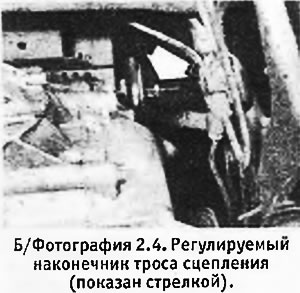2. The manufacturer recommends checking the clutch free play and adjusting it every 15,000 km, but we recommend doing this even more often, because. this operation takes a little time.
3. Check the travel of the clutch pedal by measuring the distance it will drop when depressed from the fully released position. The minimum pedal travel is specified in Specifications. Lift up the pedal in the released position and measure how much it rises. The resulting value will give the pedal free play. The minimum amount of free play is also indicated in Specifications.

4. Adjustment, if necessary, is made at the engine end of the cable where the end of the cable connects to the clutch release lever. Loosen the locknut on the threaded end and turn the nut next to it to obtain the desired amount of pedal travel. Depress the clutch pedal several times and check the pedal stroke and free play again. Repeat adjustment if necessary. When finished, tighten the locknut on the end of the cable. If you are working with a wrench, the tip must be kept from rotating with another wrench thrown over the chamfers at the inner end of the tip. Upon completion, check the operation of the clutch pedal.
